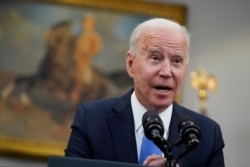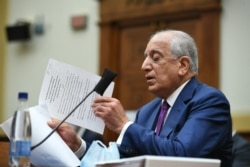The United States is hoping more money will help make up for the absence of U.S. combat troops on the ground in Afghanistan.
U.S. President Joe Biden on Friday unveiled his proposed $715 billion defense budget for fiscal year 2022, including $3.3 billion for Afghan forces.
The request is $300 million more than what the U.S. gave Afghanistan this past fiscal year. If approved by Congress, the Afghanistan Security Forces Fund money would help cover equipment and training requirements, as well as infrastructure, for the 352,000 members of the Afghan National Defense and Security Forces.
"We believe that given that we're pulling out of Afghanistan, we need to provide some additional security support for the forces there," Anne McAndrew, the Pentagon's acting Under Secretary of Defense and Chief Financial Officer, told reporters.
Military planners are also requesting $8.9 billion to cover so-called "direct war costs" in Afghanistan, about a $4 billion reduction from the previous year.
McAndrew said some of that money will help cover residual expenses from the current withdrawal from Afghanistan as well as help pay for "an over-the-horizon capability outside Afghanistan."
In addition to the military aid, Afghanistan could also be getting more funding from the U.S. State Department.
The State Department on Friday said its proposed FY 2022 budget includes about $360 million for Afghanistan — an increase of $34 million — to help combat terrorism, counter the narcotics trade and protect rights for women.
U.S. diplomats and defense officials have expressed optimism that the Afghan government will be able to survive, and that the Taliban will adhere to the deal they signed with the U.S. last year. In the agreement, in exchange for the U.S. military pullout, the Taliban promised that the country will not become a launching pad for future terror attacks.
Ambassador Zalmay Khalilzad, the U.S. special representative for Afghanistan reconciliation, has said Taliban officials have assured him they "seek normalcy."
"They have said to me that their views have evolved," Khalilzad told lawmakers earlier this month. "They say the Afghan women have rights, including political participation, education, and work. … We will have to see."
Iraq, Syria forces see cuts
While Afghan forces may be getting more money from the U.S. military, U.S. partner forces in Iraq and Syria could see their funding cut.
The Pentagon's proposed FY 2022 budget calls for just $522 million to help train and equip Iraqi security forces and vetted Syrian groups such as the U.S.-backed Syrian Democratic Forces, down from a proposed $700 million the previous year.
Under the new proposal, Iraqi forces would get just over $322 million, while the SDF and other U.S. partner forces in Syria would get $177 million, according to the Pentagon budget proposal.
The U.S. currently has about 2,500 troops in Iraq and 900 in Syria. Military officials say they expect those numbers to hold steady for the coming fiscal year.






